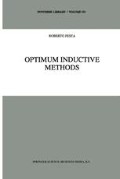Abstract
The problem of determining the optimum Dirichlet distribution — or, equivalently, the optimum GC-system — for investigating a given multivariate Bernoulli process Ex with parameter vector q=(q 1 ,...,q k ) may be referred to as the epistemic problem of optimality, or EPO. In this chapter a contextual approach to EPO is proposed.
Access this chapter
Tax calculation will be finalised at checkout
Purchases are for personal use only
Preview
Unable to display preview. Download preview PDF.
Notes
However, a statistician working on Bayesian elicitation might remark that a GD-context provides `better’ (i.e., more stable) results, because the researcher who finds that (7) is violated may wish to reconsider his external estimates - at least for D2(y°,q)] and G(q)] and possibly also for q1 - in order to come to a compromise fulfilling (3). This strategy is in line with the results obtained by many researchers (such as Novick and Jackson (1974), Hogarth (1980), Lourens (1984), Terlouw (1989)) who found that some overdetermination of the prior is very useful: inconsistencies lead to reconsideration, and consistencies give more trust in the results. This remark was suggested by Prof. Molenaar.
Notice that D(T(0 I y),0) depends both on the value 9 of 9 and on T(8 I y) which, in turn, depends both on the estimator T and the result y of the experiment y which has been performed. Whilst y and T are selected by X,the actual state of nature 0 and the actual experimental result y are, as it were, selected by `the world’.
See the justification for using the quadratic distance as provided in Chapter 4, note 6.
Theorem (22) can be proved as follows.
It should be recalled that, analogously to all formulae in Chapter 3.2, formula (3.19) does not apply only to parameters and parameter vectors but also to random variables and mixtures of parameter vectors and random variables (cf. p. 23). Hence, it also applies to any probability distribution on (q,e,) where q is a parameter vector and e,a random variable with a probability distribution which depends on the value of q.
According to Camap (ibid.,pp. 70–71) the quantity Li = C(q) occurring in (30) can be seen as a measure of “the degree of order or uniformity or regularity” of a population. In this connection, he points out that (i) in the case of a completely homogeneous population - i.e., when one q,is 1 and all others are 0 - the value of EqZ is maximum (Eq; = 1) while (ii) in the case of a maximally heterogeneous population - i.e., when q, = 1/k for all q,- the value of Eq, is minimum (Eq; = 1/k).
A number of modifications to Carnap’s terminology are made to simplify the analysis of such relationships.
Carnap’s decision to use the square error as a measure of the seriousness of the error was in keeping with a long statistical tradition which, in turn, was motivated to a large extent by the mathematical tractability of the square error. However, Carnap did not provide any theoretical reason for his proposal. For a possible `justification’ of the square error, or quadratic distance from the truth, see Chapter 4, note 6.
Carnap and Stegmüller introduced GC-systems only in (1959).
Concerning these differences between my approach and that of Carnap it should be recalled that in 1952 the equivalence between symmetrical Dirichlet distributions and C-systems was still to be recognized and the theory of verisimilitude was still to be developed.
Author information
Authors and Affiliations
Rights and permissions
Copyright information
© 1993 Springer Science+Business Media Dordrecht
About this chapter
Cite this chapter
Festa, R. (1993). The Epistemic Problem of Optimality (EPO): A Contextual Approach. In: Optimum Inductive Methods. Synthese Library, vol 232. Springer, Dordrecht. https://doi.org/10.1007/978-94-015-8131-8_8
Download citation
DOI: https://doi.org/10.1007/978-94-015-8131-8_8
Publisher Name: Springer, Dordrecht
Print ISBN: 978-90-481-4318-4
Online ISBN: 978-94-015-8131-8
eBook Packages: Springer Book Archive

